- Wondering how to get Monopoly GO! free rolls? Well, you’ve come to the right place. In this guide, we provide you with a bunch of tips and tricks to get some free rolls for the hit new mobile game. We’ll …
Best Roblox Horror Games to Play Right Now – Updated Weekly
By Adele Wilson
Our Best Roblox Horror Games guide features the scariest and most creative experiences to play right now on the platform!The BEST Roblox Games of The Week – Games You Need To Play!
By Sho Roberts
Our feature shares our pick for the Best Roblox Games of the week! With our feature, we guarantee you'll find something new to play!All Grades in Type Soul – Each Race Explained
By Adele Wilson
Our All Grades in Type Soul guide lists every grade in the game for all races, including how to increase your grade quickly!
Gameglobe Diary #4: A Purposeful Game
Gameglobe is a game creation engine and community developed by Square Enix and Bigpoint. The browser-based builder launched in closed beta in summer of 2012 and is now available for open play by anyone with an internet connection. This series will explore the features, benefits, and challenges of Gameglobe through the process of building a game from scratch. In this week’s entry, we’ll flesh out the world we’ve built with NPCs, objectives, and ambiance.
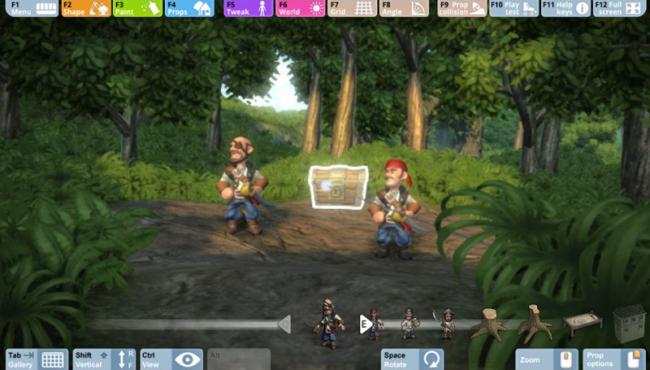
Gameglobe is a game creation engine and community developed by Square Enix and Bigpoint. The browser-based builder launched in closed beta in summer of 2012 and is now available for open play by anyone with an internet connection. This series will explore the features, benefits, and challenges of Gameglobe through the process of building a game from scratch. In this week’s entry, we’ll flesh out the world we’ve built with NPCs, objectives, and ambiance.
After a few weeks with Gameglobe, our version of Hyrule has taken physical shape thanks to the easy-to-use terrain tools and quick prop placement. However, it still feels empty, even when exploring visually-finished areas like the Lost Woods. The absence of any sound effects, music, or non-playable characters creates a world that is merely a stage, with little purpose besides looking pretty. It’s time to populate our world with more than trees and caves.

Two bandits guarding a single chest; you’re all but guaranteed gold and health cake.
Adding characters to your game is extremely easy; they, like every non-terrain object, are props that can be selected from the catalogue and dropped anywhere you please. Unlike inanimate objects, such as trees and houses that can float in mid-air, NPCs must have a surface to stand on and will fall to the nearest terrain or object when placed in the middle of nowhere. (There are workarounds to making a character float, but that is one of Gameglobe‘smany features we won’t have time to explore.)
Characters are slightly less abundant than building objects, with 48 different NPC types available—12 of which are zombified versions of the Suburbia catalogue. There’s still enough variety that most genre needs should be met; I’m using a combination of Suburbia, Pirate, and Colonial characters as my townspeople and enemies. I’m especially excited about using the Halloween-themed skeleton characters in future dungeon challenges.
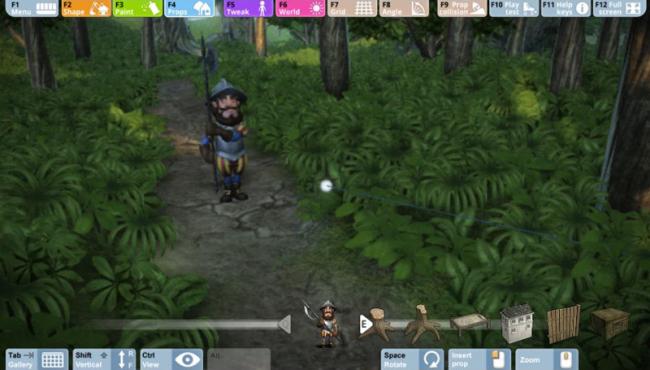
This guard isn’t very good at his job, mostly because I forced him to stand still even under attack.
Once an NPC is placed in the world, you can assign them a style of roaming—such as free or single-point sentry—and a pathgrid to determine how and where they will walk. You also have the option to assign rewards to a felled NPC, including points or the weapon they are carrying. More involved mechanics, like assigning dialogue, require the use of gameplay props. Link may be a silent protagonist, but we definitely want to incite one-way conversations with some characters.
The number of gameplay props available in Gameglobe is staggering, as are the available uses and methods of operating them. Some will be fairly obvious—like the weather box we used last week to “rain” on Link’s house—but many will require seeking out community FAQs that explain not only their basic functions but how to combine props to meet your needs. Dialogue is just one example of prop combination; while you can’t assign NPCs to talk to a character, you can create a “text box” prop with the lines you want them to say. Then, place a “proximity sensor” prop near the NPC and plug the text box into it with its power turned “off.” When your character enters the assigned proximity bubble near the NPC, the text will appear—and when they walk away, it vanishes—making it look like the character is speaking. This trick can be used anywhere, so you could have warning signs or telepathic text appear when a character walks near a certain location, or display the contents of a letter they pick up.
As you learn what the different gameplay props do and can be used for, the in-game possibilities become seemingly endless. The “seeker” prop causes whatever is attached to it to seek out its assigned goal. You could use this to race an NPC to an objective, have a blood-thirsty enemy hunt you down, or have a character in need seek you out with a request. Unless told otherwise, the seeker will stick with their destination, so we could have a fairy-esque ball of light dedicatedly follow our Link around the world.
The “aimer” makes its associated prop always face a specific target. This could control player-seeking turrets or be used for challenging puzzles where an entrance is always blocked when you approach. The “delayer” came in handy when building the intro scene to our A Link to the Past recreation; Zelda’s classic telepathic speech needed to come in a few lines at a time. With a delayer assigned to each text prop and adjusted for a few extra seconds, Zelda is able to call out to the player deliberately and without feeling rushed.
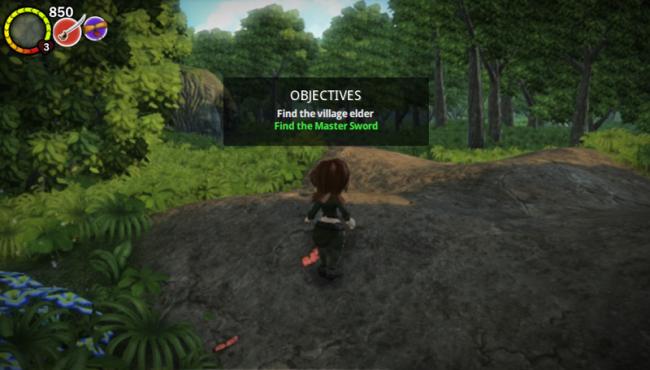
Green objectives have been completed, even if they’re out of sequence.
Another set of critical and extremely useful props are the “objective” items. Objectives allow you to direct your player towards their next step, or even provide multiple assignments simultaneously—a player’s current list of objectives is visible by pressing the Home key. Since Gameglobe has no way of knowing what your objectives are or when they’re completed, it’s up to you to set the start point trigger—it could be automatic, related to proximity, powering on an object, etc.—and confirm if an objective has been completed or failed by relating it to a linked end point.
One objective in our level is to “Find the Master Sword.” Currently, this objective is started once the player enters the Lost Woods and is marked as completed when they pull the sword out of the stone. This was the hardest aspect of building in Gameglobe yet, and I actually ended up using a hacky workaround for the “objective complete” confirmation since the suggestion I read for using an “inverter” and “connector”—yes, even more gameplay props—refused to work properly. Luckily, with so many props and functions available, there’s usually more than one way to pluck a cucco.
Objectives can take you all the way to the directed end of your game itself, but everything in between still feels static without musical accompaniment. While adding a single song soundtrack to your game is as easy as dropping the “music” prop into the level, a giant world like Hyrule needs different songs for each region. The proximity prop came in handy yet again for this, allowing Link’s house, Kakariko Village, the Lost Woods, and Lake Hylia to all have their own song or sound effects pulled from Gameglobe‘s expansive library of offerings (there are five different “rain” sounds alone). One-off effects can also be added and tied to a related prop or event, like an explosion or, in the case of the Master Sword, successfully completing an objective. Even as the world and other objectives continue taking shape, music makes it feel less like a work in progress and more like an actual, playable world.
My experience with Gameglobe has been consistently rewarding and often surprising: the level of visual detail and straightforward tools available lulled me into expecting a simple engine with little room for customization. What I found was an in-depth system that makes it easy to quickly create the basis for your game, then offers almost every low-level tool you could need to dive in deep and adjust the critical characteristics of your personal creation. Even using the same set of tools and given the same assignment, a group of creators would still come up with different—but all playable—results, which is easily visible in the weekly “build a ___” challenges presented by the Gameglobe team. Whether you spend a few hours or a few weeks building your Gameglobe world, every step feels like a success.
Bloopers
A lot of my time with Gameglobe was spent messing with props and learning from mistakes. Here are a few “learning moments” that didn’t make it into previous diaries.
Lake Hylia in Bloom
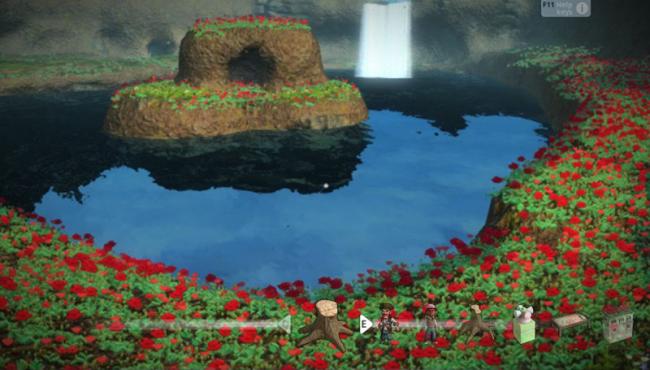
The terrain paint toolset has 8 slots for storing quick-access paint splotches. I initially thought this was for convenience. Turns out you can only use eight paints maximum, and replacing one will replace all its associated terrain currently present in the world. This was actually a useful lesson to learn, but surprising to find my “rough sand” had suddenly sprouted thousands of red poppies.
The Permanent Door to Nowhere
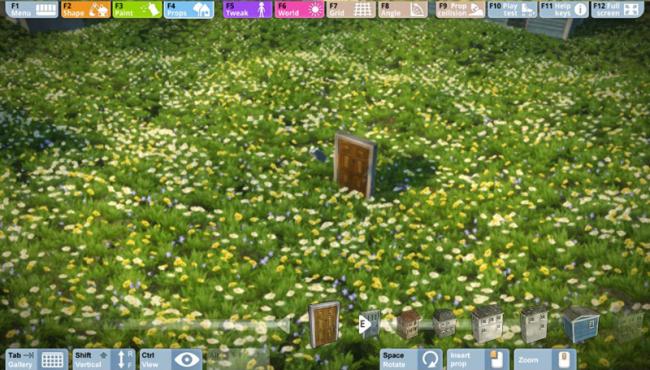
One of the biggest challenges I faced while building with Gameglobe was getting used to its fully 3D environment and absolutely tiny prop cursor. Intersecting a prop to delete it often took longer than building the surrounding terrain. In the case of this misplaced door, I never got the cursor to highlight it. It may or may not still exist in Kakariko Village, waiting to be discovered…
Respect Your Elders
I did want to know if friendly NPCs are killable (they aren’t), but the old woman’s reaction to being slashed with a knife is pretty priceless. She waves her cane and says “Ah-ah-ah!” like you’re a little kid eating candy before dinner, and not an adult who just tried to murder her.
- Read Part 1: Building with Gameglobe
- Read Part 2: The Trouble With Trees
- Read Part 3: Playing with Portals
More articles...
Monopoly GO! Free Rolls – Links For Free Dice
By Glen Fox
Wondering how to get Monopoly GO! free rolls? Well, you’ve come to the right place. In this guide, we provide you with a bunch of tips and tricks to get some free rolls for the hit new mobile game. We’ll …Best Roblox Horror Games to Play Right Now – Updated Weekly
By Adele Wilson
Our Best Roblox Horror Games guide features the scariest and most creative experiences to play right now on the platform!The BEST Roblox Games of The Week – Games You Need To Play!
By Sho Roberts
Our feature shares our pick for the Best Roblox Games of the week! With our feature, we guarantee you'll find something new to play!All Grades in Type Soul – Each Race Explained
By Adele Wilson
Our All Grades in Type Soul guide lists every grade in the game for all races, including how to increase your grade quickly!







